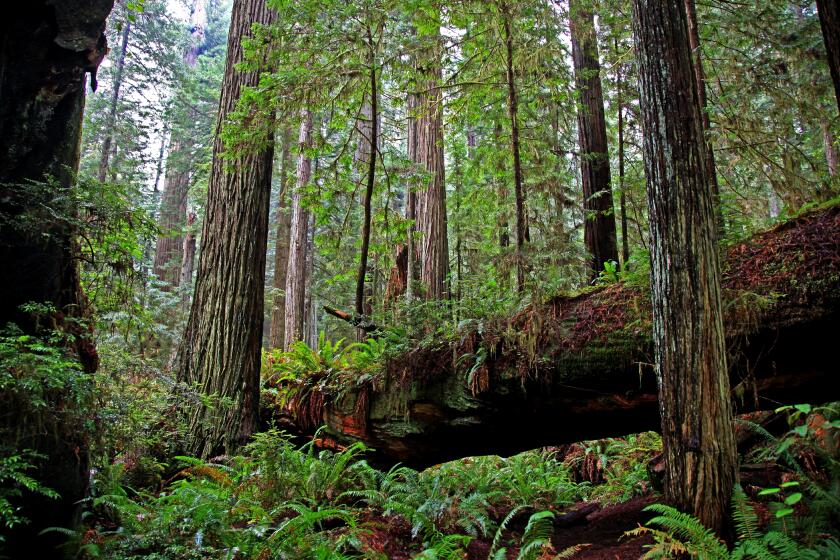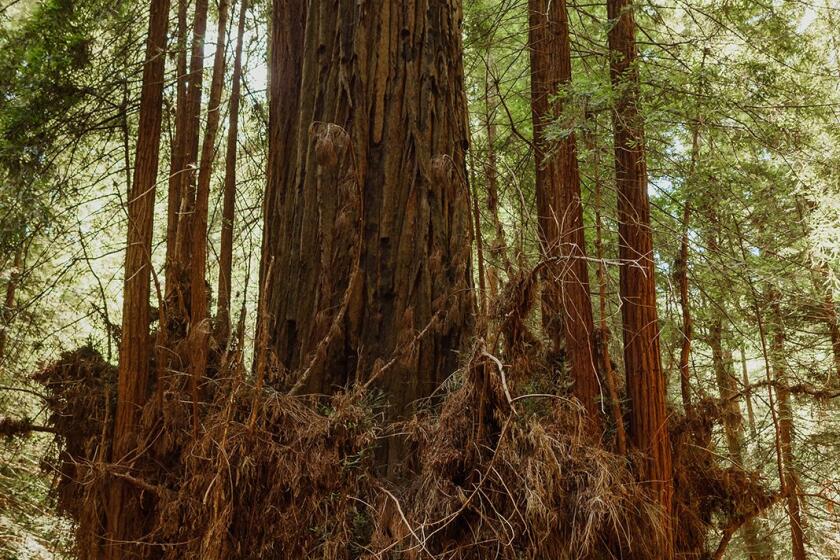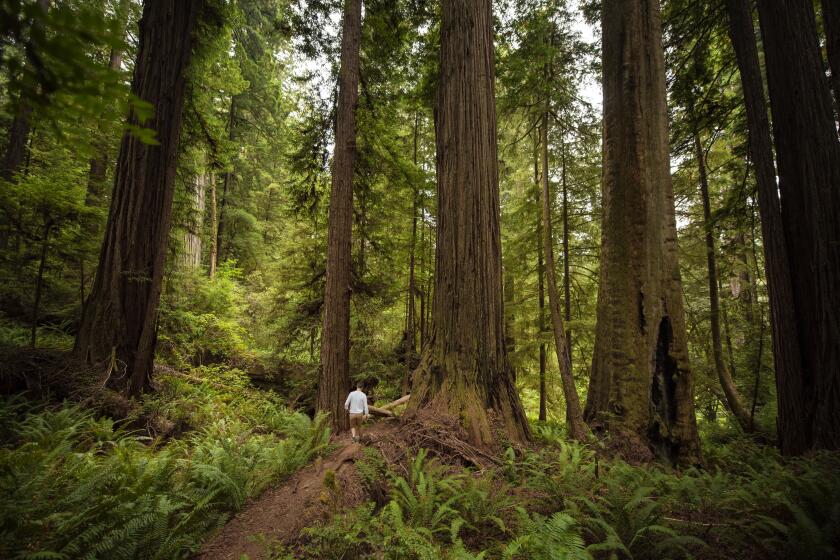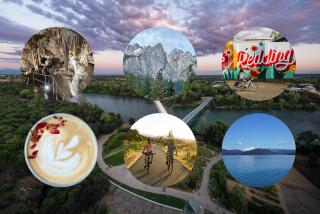The mighty coast redwoods are born to change. But can they evolve fast enough to survive climate warming?
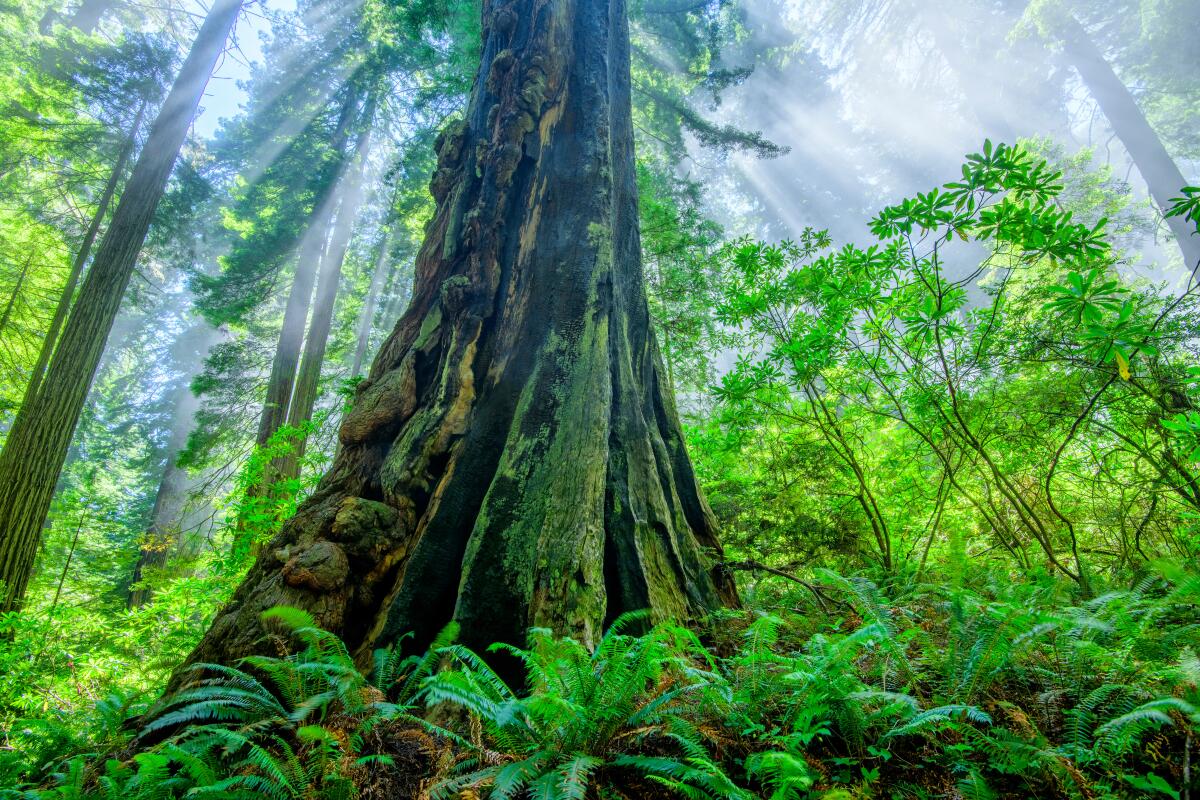
- Share via
Coast redwoods — enormous, spectacular trees, some reaching nearly 400 feet, the tallest plants on the planet — thrive mostly in a narrow strip of land in the Pacific Northwest of the United States. Most of them grow from southern Oregon down into Northern California, snugged up against the rugged Pacific coast.
They have grown by slowly responding to moisture and rich alluvial soil over millenniums, combined with a genetic payload that pushes them to the upper limits of tree height. They are at risk — down to perhaps 70,000 individuals, falling from at least a half-million trees before humans arrived, but that’s not a new story, for we are all at risk.
Redwoods, like all trees, are engineered marvels. People don’t tend to think of natural things as “structures,” leaving that term to stand in for buildings, bridges and dams. But although trees were not built by humans, they didn’t just happen. They have come into their own through the inexorably turning wheels of natural selection and evolution, responding to environmental pressures, genetic drift and mutation (they even have two kinds of leaves that help the trees adapt to both wet and dry conditions). They are born to change, just as humans are born to change.
The threats of jail and fines aren’t enough to keep Hyperion, Earth’s tallest tree, safe from Redwood National Park hikers. In-park education is key.
Evolution is usually a very slow process, although sometimes it’s surprisingly quick. New, intense pressures of a warming and changing climate are speeding things up, and forcing researchers and horticulturists to examine approaches to climate change resilience and technologies like geographic information systems.
Of course, there are differences between man-made edifices and trees. A structure or building typically is a sort of island unto itself, separate from its neighbors; in contrast, the coast redwood is an ecosystem with enormously broad consequences for other life forms.
Life is folded in and among the redwoods, below and within and about them. The trees are integrators, bringing together many life forms. Some of these life forms rely on the tree, others on occupants in and around the tree.
The coast redwood hosts so many different ecological interactions that it’s faintly ridiculous. Consider the wandering salamander, which usually spends its entire life high in the canopy, but sometimes must jump out to escape predators. Without wings or gliding, it falls from a great height only to land perfectly unharmed on the ground.
Save the Redwoods League hopes to raise $6.5 million to buy and preserve 394 acres in Sonoma County, including an ancient redwood called the Clar Tree.
It took scientists dropping these creatures into a wind tunnel and filming them with high-speed cameras to understand why they didn’t end up as a wet splat on the forest floor. As it turns out, the salamander’s flattened body shape and large feet with long toes create just enough drag and balance for a soft landing.
Redwoods are so large that one reportedly was found to house a Sitka spruce, 8 feet tall, growing far off the ground within the larger tree. Redwoods also have served for millenniums as nesting habitat for huge California condors, with wingspans of nearly 10 feet.
There’s also a place for the tiny, living side by side with all of the largeness tucked in the complex, secret interstices of these trees. Nestled into extensive mats of ferns that grow high up in redwood canopies, researchers find aquatic crustaceans called copepods that normally would live in larger bodies of water. No one knows how they got into the trees, but the fern mats trap enormous quantities of moisture from rain and fog, creating wetlands in the sky.
California’s Redwood National Park officials have made the 380-foot redwood off-limits. Visitors caught near it could face six months in jail and a $5,000 fine.
Yet even species as enduring as coast redwoods are affected by climate change. Diminished moisture stresses the trees, making them grow with less vigor. New fire dangers put them at risk, and more frequent floods erode the big trees’ footing. But redwoods also are adapting.
A 2018 survey of nine large redwood trees found a total of 137 species of lichen growing on the trees, including several that were new to science. One was Xylopsora canopeorum, whose specific name celebrates the canopy where it was discovered.
This lichen seems to be unique to the warmer and drier forests in California’s Sonoma and Santa Cruz counties, in the southern part of coast redwoods’ range. This is an exciting finding, for it provides evidence that new forms of life — ecosystem partners — may be evolving in sync with trees that are also evolving in the face of climate change.
A pair of redwoods grow just outside my office at the Huntington in San Marino, which is some 700 miles south of the coast redwood’s usual range. I’ve resisted giving names to this duo, although many giant redwoods have monikers like Adventure, Brutus, Nugget, Paradox and Atlas — most named by the scientists who first quantified their extreme heights.
The redwoods outside my window are perhaps 100 feet tall — puny by comparison to their northern brethren. But they are healthy, and will continue to be shaped by their immediate environments. They’ve traveled far to get to here, planted more than a half-century ago by an earlier generation of horticulturalists, and they’re thriving in their new home. We should all be so lucky.
Daniel Lewis teaches environmental humanities at Caltech and is a senior curator at the Huntington. He is author of the forthcoming book “Twelve Trees: The Deep Roots of Our Future.” This article was produced in partnership with the Conversation.
More to Read
A cure for the common opinion
Get thought-provoking perspectives with our weekly newsletter.
You may occasionally receive promotional content from the Los Angeles Times.
